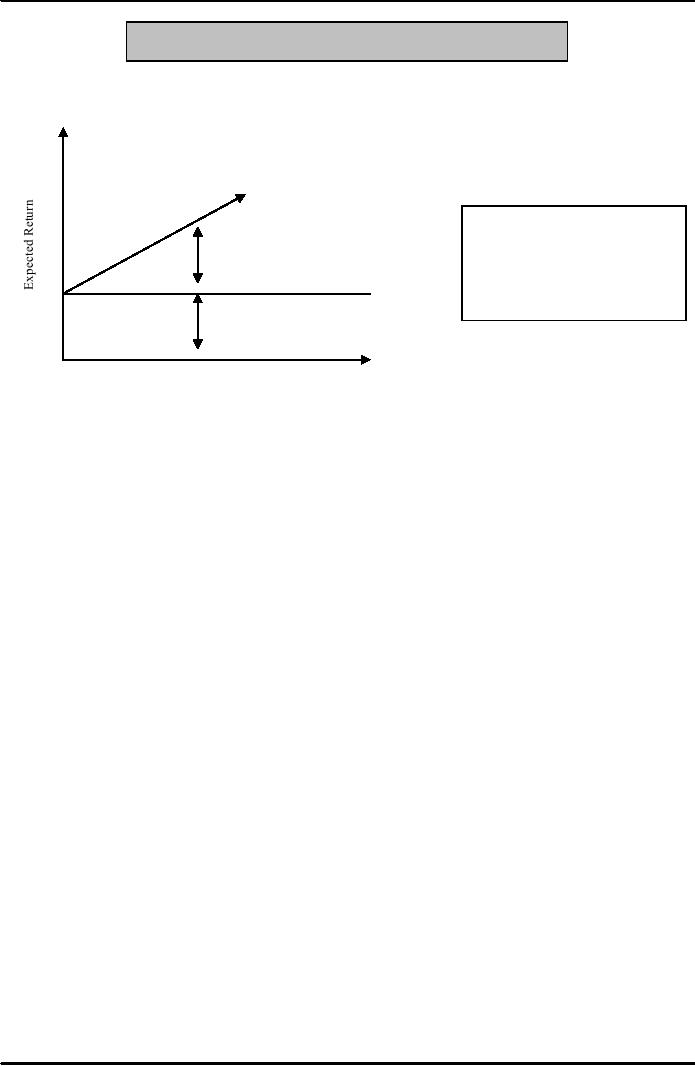 |

Money
& Banking MGT411
VU
Lesson
11
MEASURING
RISK
Measuring
Risk
Variance
and Standard Deviation
Value
at Risk (VAR)
Risk
Aversion & Risk Premium
Measuring
Risk
Most
of us have an intuitive sense for
risk and its
measurement;
The
wider the range of outcomes the greater the
risk
A
financial instrument with no
risk at all is a risk-free
investment or a risk-free
asset;
Its
future value is known with
certainty and
Its
return is the risk-free rate of
return
If
the risk-free return is 5 percent, a
$1000 risk-free investment
will pay $1050, its
expected
value,
with certainty.
If
there is a chance that the payoff
will be either more or less
than $1050, the investment
is
risky.
We
can measure risk by measuring the
spread among an investment's possible
outcomes. There
are
two measures that can be
used:
Variance
and Standard Deviation
Measure
of spread
Value
at Risk (VAR)
Measure
of riskiness of worst case
Variance
The
variance is defined as the probability
weighted average of the squared
deviations of the
possible
outcomes from their expected
value
To
calculate the variance of an investment,
following steps are
involved:
Compute
expected value
Subtract
expected value from each possible
payoff
Square
each result
Multiply
by its probability
Add
up the results
Compute
the expected value:
($1400
x �) + ($700 x �) = $1050.
Subtract
this from each of the
possible payoffs:
$1400-$1050=
$350
$700-$1050=
$350
Square
each of the
results:
$3502 =
122,500(dollars)2
and
($350)2 =
122,500(dollars)2
Multiply
each result times its
probability and adds up the
results:
�
[122,500(dollars)2]
+ � [122,500(dollars)2]
=
122,500(dollars)2
34

Money
& Banking MGT411
VU
More
compactly;
Variance
= �($1400-$1050)2 +
�($700-$1050)2
=
122,500(dollars)2
Standard
Deviation
The
standard deviation is the square
root of the variance,
or:
Standard
Deviation (case 1)
=$350
Standard
Deviation (case 2)
=$528
The
greater the standard deviation, the
higher the risk
It
more useful because it is measured in the
same units as the payoffs
(that is, dollars and
not
squared
dollars)
The
standard deviation can then
also be converted into a
percentage of the initial
investment,
providing
a baseline against which we can measure
the risk of alternative
investments
Given
a choice between two investments with the
same expected payoff, most
people would
choose
the one with the lower
standard deviation because it
would have less risk
Value
at Risk
Sometimes
we are less concerned with
the spread of possible outcomes than we
are with the
value
of the worst outcome.
To
assess this sort of risk we
use a concept called "value
at risk."
Value
at risk measures risk at the
maximum potential
loss
Risk
Aversion
Most
people don't like risk and
will pay to avoid it;
most of us are risk
averse
A
risk-averse investor will always
prefer an investment with a
certain return to one with
the
same
expected return, but any amount of
uncertainty.
Buying
insurance is paying someone to
take our risks, so if someone
wants us to take on risk
we
must
be paid to do so
Risk
Premium
The
riskier an investment the higher
the compensation that investors require
for holding it
the
higher the risk
premium
Riskier
investments must have higher expected
returns
There
is a trade-off between risk and expected
return;
You
can't get a high return
without taking considerable
risk.
35

Money
& Banking MGT411
VU
Figure:
The Trade-off between Risk
and Expected
Return
Higher
Risk=Higher Expected Return
The
higher the risk, the
higher
the
expected return. The
risk
Risk
Premium
premium
equals the expected
return
on the risky investment
minus
the risk-free return.
Risk-
Free Return
Risk
36
Table of Contents:
- TEXT AND REFERENCE MATERIAL & FIVE PARTS OF THE FINANCIAL SYSTEM
- FIVE CORE PRINCIPLES OF MONEY AND BANKING:Time has Value
- MONEY & THE PAYMENT SYSTEM:Distinctions among Money, Wealth, and Income
- OTHER FORMS OF PAYMENTS:Electronic Funds Transfer, E-money
- FINANCIAL INTERMEDIARIES:Indirect Finance, Financial and Economic Development
- FINANCIAL INSTRUMENTS & FINANCIAL MARKETS:Primarily Stores of Value
- FINANCIAL INSTITUTIONS:The structure of the financial industry
- TIME VALUE OF MONEY:Future Value, Present Value
- APPLICATION OF PRESENT VALUE CONCEPTS:Compound Annual Rates
- BOND PRICING & RISK:Valuing the Principal Payment, Risk
- MEASURING RISK:Variance, Standard Deviation, Value at Risk, Risk Aversion
- EVALUATING RISK:Deciding if a risk is worth taking, Sources of Risk
- BONDS & BONDS PRICING:Zero-Coupon Bonds, Fixed Payment Loans
- YIELD TO MATURIRY:Current Yield, Holding Period Returns
- SHIFTS IN EQUILIBRIUM IN THE BOND MARKET & RISK
- BONDS & SOURCES OF BOND RISK:Inflation Risk, Bond Ratings
- TAX EFFECT & TERM STRUCTURE OF INTEREST RATE:Expectations Hypothesis
- THE LIQUIDITY PREMIUM THEORY:Essential Characteristics of Common Stock
- VALUING STOCKS:Fundamental Value and the Dividend-Discount Model
- RISK AND VALUE OF STOCKS:The Theory of Efficient Markets
- ROLE OF FINANCIAL INTERMEDIARIES:Pooling Savings
- ROLE OF FINANCIAL INTERMEDIARIES (CONTINUED):Providing Liquidity
- BANKING:The Balance Sheet of Commercial Banks, Assets: Uses of Funds
- BALANCE SHEET OF COMMERCIAL BANKS:Bank Capital and Profitability
- BANK RISK:Liquidity Risk, Credit Risk, Interest-Rate Risk
- INTEREST RATE RISK:Trading Risk, Other Risks, The Globalization of Banking
- NON- DEPOSITORY INSTITUTIONS:Insurance Companies, Securities Firms
- SECURITIES FIRMS (Continued):Finance Companies, Banking Crisis
- THE GOVERNMENT SAFETY NET:Supervision and Examination
- THE GOVERNMENT'S BANK:The Bankers' Bank, Low, Stable Inflation
- LOW, STABLE INFLATION:High, Stable Real Growth
- MEETING THE CHALLENGE: CREATING A SUCCESSFUL CENTRAL BANK
- THE MONETARY BASE:Changing the Size and Composition of the Balance Sheet
- DEPOSIT CREATION IN A SINGLE BANK:Types of Reserves
- MONEY MULTIPLIER:The Quantity of Money (M) Depends on
- TARGET FEDERAL FUNDS RATE AND OPEN MARKET OPERATION
- WHY DO WE CARE ABOUT MONETARY AGGREGATES?The Facts about Velocity
- THE FACTS ABOUT VELOCITY:Money Growth + Velocity Growth = Inflation + Real Growth
- THE PORTFOLIO DEMAND FOR MONEY:Output and Inflation in the Long Run
- MONEY GROWTH, INFLATION, AND AGGREGATE DEMAND
- DERIVING THE MONETARY POLICY REACTION CURVE
- THE AGGREGATE DEMAND CURVE:Shifting the Aggregate Demand Curve
- THE AGGREGATE SUPPLY CURVE:Inflation Shocks
- EQUILIBRIUM AND THE DETERMINATION OF OUTPUT AND INFLATION
- SHIFTS IN POTENTIAL OUTPUT AND REAL BUSINESS CYCLE THEORY